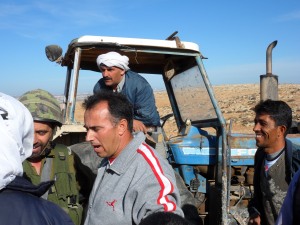If I were a cinematographer, I’d show you the scene this way. First you see small groups of Palestinian men and children sitting on rocks on a sunny hillside, mostly in everyday, modern clothes, many smoking as they chat. The camera passes over a few Israelis and a Westerner sitting among them, apparently basking in the sun. To one side, women, more of whom are in traditional dress, are preparing tea over an open fire. You might think it’s a village picnic with a few guests, but then the soundtrack begins to pick up a few agitated voices among the conversations, especially an older man wearing a keffiya and holding a staff who is gesticulating vigorously. The camera follows his gestures, panning across a partially ploughed field and a stationary tractor, pausing to show some temporary buildings on a hillside, and then tracking back to the edge of the field where a loosely ranked collection of Israeli soldiers, border police and civil police watch the seated Palestinians and Israelis. This is no picnic.

Army, border police and civilian police blocking the field at Umm el-Arayes
The outpost settlement on the hill, unauthorized even by Israeli authorities, is Mitzpe Yair, located in the especially troubled South Hebron Hills area, where many Palestinians face eviction and the destruction of property to make way for military firing zone 918. The villagers have come from Umm el-Arayes to plough a field owned by their families that the settlers have worked on, thereby turning it into “disputed land” in the eyes of the “Civil” Administration that still governs some 60% of the West Bank, Area C, under the 1993 Oslo agreements. Local Palestinians have been subject to violence and intimidation from the settlers of Mitzpe Yair before, including shepherds from Umm el-Arayes. Activists from the Israeli-Palestinian group Ta’ayush, a grassroots partnership to end the occupation through non-violent direct action, have already been to this spot, have come from Jerusalem early on a Shabbat morning, as they do each week, joining with the Palestinians to try and shield them from physical attack or at least document the violence and obstruction. This time, on December 1st 2012, it’s not the settlers who are the problem, but the whole panoply of occupation forces.
Before the camera started rolling for the scene above, tens of Palestinians and the five Ta’ayush activists allocated to this site (while another ten or so were doing similar work in small groups elsewhere in the area) spread across the field, making ourselves busy by removing stones and burning thorns as the tractor started to plough. Little had been achieved before a contingent of soldiers who had been observing nearby rushed across the rocks and earth, some bringing the tractor to a halt while others ordered everyone else to stop work. By side of the stalled tractor an argument broke out between the commanding officer (who declared the field a “closed military area”), Palestinians (including the tractor driver and the owner of the land), and the Israeli activists. The script of the exchange was already known to the players: “It’s our land and we have the right to plough it;” “you have no legal authority to declare a closed military zone because of a land dispute;” “you’re closing the land to those who own it, but not to the settlers;” and from the military side; “this is only temporary until the dispute is settled in a few days;” (a claim that had been repeated many times already) and “we can detain whom we want.” Both the military and the activists filmed the event and each other up close. Soldiers and activists showed each other documents, though only the former had the weapons with which to authorize their words.

Under the lens of occupation

Arguing over access to the field
For a while, there was a brief truce as the officer agreed to wait until the representative of the Civil Administration arrived, but the tractor engine had to remain silent. The uniformed official turned up, along with a contingent of border police and a few civilian police, bringing their own cameras. The arguments were rehearsed again, this time in Arabic as well as Hebrew, the closure document was produced and photographed, but now the closure order was to be enforced under threat of arrest.
Slowly, the field emptied as a ragged line of military police moved towards an edge of the field, accompanied by rather than pushing or moving the remonstrating Palestinians. The order was not defied, but it was not obeyed with any urgency.

Leaving the field
When everyone had gathered by the side of the field, the border police commander remained unhappy, initiating yet another slow, reluctant movement some twenty meters up onto the hillside. There we sat, as a kind of protest, holding the occupation forces on the spot, exercising a minor power to irritate, to disturb a routine, to exact a small cost, to remind them that there was an issue they had promised to address even under the terms of the unjust laws of occupation. Every day a little Naqba, every day a little resistance. We sat under the watch of the boots on the ground and those in vehicles on both sides of the field, their cameras still recording. We were a fleck in the eye of the occupation as it observed us through its lenses; the fleck in the eye of an enormous bureaucratic-military system of cold and cynical rules and regulations that is blind to the difference between its laws and justice. Yet, we could see from our shared hillside a partnership between Israelis and Palestinians that is just, and a justice that is peace.